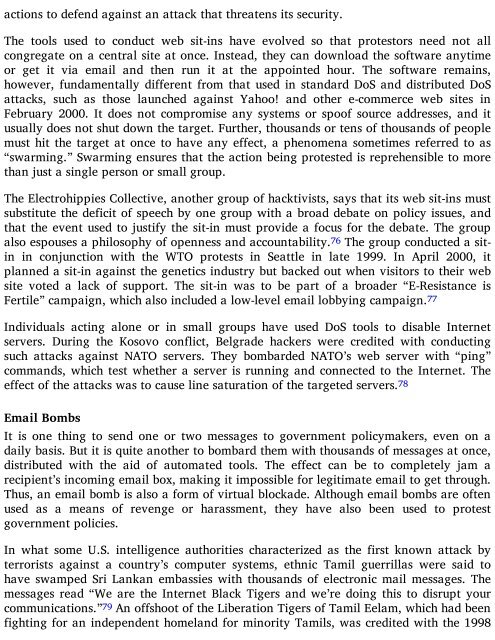RAND_MR1382
Create successful ePaper yourself
Turn your PDF publications into a flip-book with our unique Google optimized e-Paper software.
actions to defend against an attack that threatens its security.<br />
The tools used to conduct web sit-ins have evolved so that protestors need not all<br />
congregate on a central site at once. Instead, they can download the software anytime<br />
or get it via email and then run it at the appointed hour. The software remains,<br />
however, fundamentally different from that used in standard DoS and distributed DoS<br />
attacks, such as those launched against Yahoo! and other e-commerce web sites in<br />
February 2000. It does not compromise any systems or spoof source addresses, and it<br />
usually does not shut down the target. Further, thousands or tens of thousands of people<br />
must hit the target at once to have any effect, a phenomena sometimes referred to as<br />
“swarming.” Swarming ensures that the action being protested is reprehensible to more<br />
than just a single person or small group.<br />
The Electrohippies Collective, another group of hacktivists, says that its web sit-ins must<br />
substitute the deficit of speech by one group with a broad debate on policy issues, and<br />
that the event used to justify the sit-in must provide a focus for the debate. The group<br />
also espouses a philosophy of openness and accountability. 76 The group conducted a sitin<br />
in conjunction with the WTO protests in Seattle in late 1999. In April 2000, it<br />
planned a sit-in against the genetics industry but backed out when visitors to their web<br />
site voted a lack of support. The sit-in was to be part of a broader “E-Resistance is<br />
Fertile” campaign, which also included a low-level email lobbying campaign. 77<br />
Individuals acting alone or in small groups have used DoS tools to disable Internet<br />
servers. During the Kosovo conflict, Belgrade hackers were credited with conducting<br />
such attacks against NATO servers. They bombarded NATO’s web server with “ping”<br />
commands, which test whether a server is running and connected to the Internet. The<br />
effect of the attacks was to cause line saturation of the targeted servers. 78<br />
Email Bombs<br />
It is one thing to send one or two messages to government policymakers, even on a<br />
daily basis. But it is quite another to bombard them with thousands of messages at once,<br />
distributed with the aid of automated tools. The effect can be to completely jam a<br />
recipient’s incoming email box, making it impossible for legitimate email to get through.<br />
Thus, an email bomb is also a form of virtual blockade. Although email bombs are often<br />
used as a means of revenge or harassment, they have also been used to protest<br />
government policies.<br />
In what some U.S. intelligence authorities characterized as the first known attack by<br />
terrorists against a country’s computer systems, ethnic Tamil guerrillas were said to<br />
have swamped Sri Lankan embassies with thousands of electronic mail messages. The<br />
messages read “We are the Internet Black Tigers and we’re doing this to disrupt your<br />
communications.” 79 An offshoot of the Liberation Tigers of Tamil Eelam, which had been<br />
fighting for an independent homeland for minority Tamils, was credited with the 1998










![Genki - An Integrated Course in Elementary Japanese II [Second Edition] (2011), WITH PDF BOOKMARKS!](https://img.yumpu.com/58322134/1/180x260/genki-an-integrated-course-in-elementary-japanese-ii-second-edition-2011-with-pdf-bookmarks.jpg?quality=85)
![Genki - An Integrated Course in Elementary Japanese I [Second Edition] (2011), WITH PDF BOOKMARKS!](https://img.yumpu.com/58322120/1/182x260/genki-an-integrated-course-in-elementary-japanese-i-second-edition-2011-with-pdf-bookmarks.jpg?quality=85)





